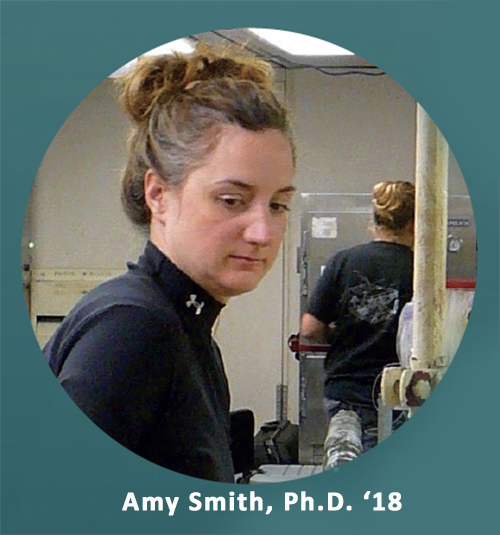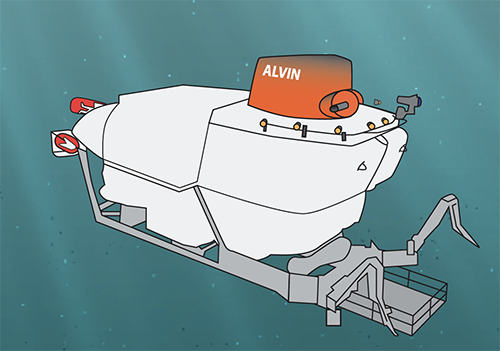Novel microbes provide clues to the origins of life on Earth ... and beyond?
From the Winter 2023 issue of the Oregon Stater magazine
By Nancy Steinberg
Amy Smith has long been fascinated by the idea of life on other planets. But when it came time for graduate school, instead of looking up to the heavens to study astrobiology, as the study of extraterrestrial life is known, she looked down. Way, way down.
Smith, Ph.D. ’18, looked for something resembling alien life by looking below a half-mile of ocean water off the Washington coast, through mud the depth of three football fields, and then a bit further into a hole in the bedrock. In this hole in the bottom of the ocean, she and her research team used custom-designed microbial collectors to look for microbes that live not in seawater, but in the fluid flowing through an underground aquifer in the Earth’s crust.

This particular aquifer is near the Juan de Fuca Ridge, a place off the coast of Washington and British Columbia where two tectonic plates are moving apart. Magma wells up in the rift to create new seafloor. The aquifers are devoid of sunlight and oxygen, two factors necessary for most life on Earth’s surface. Heat from the inner layers of the Earth warms the fluid in the aquifers to nearly 150oF (65oC). Nearby, there are hydrothermal vents with bizarre lipstick-tube tubeworms and smoking chimneys, an ecosystem whose food web foundation is chemosynthesis, driven by the chemicals that emanate from the Earth’s interior, rather than photosynthesis, driven by sunlight.
Starting with her master’s degree at Portland State University and continuing with her doctoral research working with Rick Colwell and Martin Fisk at Oregon State’s College of Earth, Ocean, and Atmospheric Sciences, Smith had a lot of questions about the microbes in these aquifers. The environments in which they thrive likely resemble conditions on other planets, as well as very early Earth when life first emerged. What microbes live in these aquifers? How do they survive? How are they related to other microbes on Earth? Finding answers required first getting her hands on some.
he team needed to deploy microbial collectors into the aquifer, ensuring that only aquifer water, and not the seawater above it, was sampled. Fisk had been working on this problem for a long time. He surmised that the microbes grew on minerals found within the rocks, so he decided to try to mimic those conditions, designing a set of chambers, called flow cells, that could be loaded with mineral grains of several types. He hoped these would be colonized by microbes. Fluid was pumped through the chambers with a novel kind of pump.
There was not much time to test the setup before it was deployed to the ocean bottom, into a “borehole” in the bedrock created by the removal of a rock sample taken by another research program. The borehole was capped, cutting the microbial sampler off from the ocean water. And then, the research team waited.
For four years.
When that time came to an end, Smith was just starting her master’s program at PSU. She went on her very first research cruise to oversee the retrieval of the samplers, riding along for three and a half weeks of the four-week expedition before the ship’s resources turned to her research. As the famed submersible Alvin descended to the borehole to pull out her samplers, she waited back at sea level, nervous about what was happening below and wondering whether she would have anything to work with once the samplers were delivered.

Her very first glimpse of the contents of the samplers was underwhelming.
“It just looked like wet rock to me,” she recalls. “I didn’t know what I was expecting, but I thought that maybe I would see some sort of biofilm or something. So, I thought, ‘Man, there’s nothing here.’”
As the ship pitched and rolled, she put samples under the microscope, and her outlook changed immediately.
“I saw things that I’d never seen before. At the time, I didn’t have a way to take videos or photos, so I just had to write down everything. There were some weird things floating around in there, all different types of motion and different shapes of organisms. I just couldn’t even have imagined what I saw.”
Although most of the microbial varieties Smith found were not able to be cultured, or grown in the laboratory, she submitted her samples for DNA sequencing. Her analysis revealed not only “who” was there, or at least their nearest familial relatives, but something about how they survive, as well.
First, among the dozens of species that colonized the mineral grains, 11 were novel, or never before described by scientists.
Second, she found that some of them used an atypical metabolic pathway, using chemicals originating in the rock itself.
“Sea water interacts with iron in the common mineral olivine to release hydrogen. And if you have hydrogen, that’s an energy source — that’s like microbial junk food,” explains Rick Colwell, microbial ecology expert. To use that energy to assemble membranes and provide organismal structure, microbes need carbon, which comes from carbon dioxide sourced from the rock and from carbon compounds dissolved in the aquifer water.
One of the novel species caught Smith’s eye. “This organism’s genome was the most interesting because I didn’t find any evidence that it could use organic carbon like most other life,” Smith says. “And so, it was the most early Earth-like, to me, and possibly relevant to astrobiology. In addition, it was abundant in the microbial community, and so I thought it might serve as the base of the food chain in this environment.”
Because she and her team were the first to identify this new species, they got to name it: It is now known as Candidatus Acetocimmeria pyornia. “Cimmeria” means “dweller of dark land beyond the ocean.” The “pyornia” part is short for Pyornkrachzark, the Rock Biter character from the 1984 film “The NeverEnding Story.”
In truth, it is not that surprising to find novel species of microbes. There’s likely more that we don’t know about the microbial world than we do know, including huge numbers of undiscovered species. So why does this organism matter?
“Rock Biter” and the other microbes in subsea aquifers can give us clues as to how life on Earth started and how it could evolve on other planets with similar conditions. “For half of the Earth’s history, it was without oxygen gas in the atmosphere or ocean,” Smith points out. “So, the subsea aquifer environment, I imagine, would be very similar to what it was like on early Earth.”
The team thinks that the experiment demonstrates that the ocean crust provides the base of a food chain driven only by Earth’s chemical energy. Further, they point out that Smith’s newly discovered microbes live in an environment that is predicted to exist on other planets.
Water and rock are common throughout the solar system and galaxy, so organisms like “Rock Biter” could live on almost any rocky planet. And if life originates on one planet, it can be transferred to other planets in the solar system and possibly beyond. Earth’s life, the team says, could have been introduced from another planet.
So perhaps we need to look up and down at the same time.

